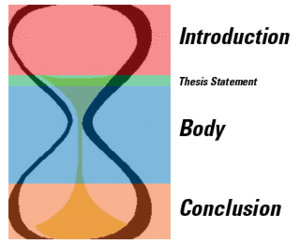How should an essay be organized?
Strong writing is well-organized. A love letter will ramble, perhaps, and in that way conveys spontaneity, warmth, and intimacy. But in academic and professional writing it is always advisable to distinguish separate points and arrange them in a logical and effective order. Sentences are organized into paragraphs, and paragraphs are organized into essays.

Think of the essay as an hourglass, wide at the top, slowly narrowing to the center, then widening again at the bottom. The introduction begins at the top: the widest part of the hourglass — and slowly narrows to the thesis. Your body paragraphs, since they address the topic in the most detail, would be the at the neck of the hourglass, and your conclusion will flow out again to the general.
Some kinds of academic writing follow specific models of organization. Research reports in the natural sciences are often structured as follows:
- introduction
- methods and materials
- results
- discussion
- conclusions
Problem-solution papers usually contain the following components:
- statement of problem
- background information
- suggested solutions
- evaluation of solutions
- solution proposal
Whether you follow a prescribed format or design the structure of your essay as you write it, organization is based on the expectations of your reader and the logic of what you want to say. The best method of organization is the one that helps you to communicate most effectively.
Your essay should begin with a title, then proceed to an opening sentence, introduction, thesis statement, body paragraphs (with topic sentences, unity, and transitions), and end with the conclusion.
